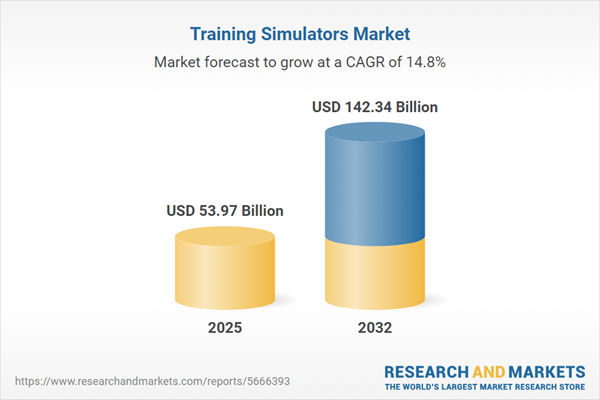Speak directly to the analyst to clarify any post sales queries you may have.
The Training Simulators Market equips organizations with advanced simulation technologies, enabling streamlined workforce development and improved compliance in dynamic operational environments. Senior leaders leverage simulation-based strategies for targeted upskilling, risk control, and sustained agility in evolving sectors.
Market Snapshot: Strategic Outlook on the Training Simulators Market
Rapid expansion characterizes the Training Simulators Market, driven by heightened demand for digital learning and robust compliance requirements across numerous industries. Aerospace, healthcare, automotive, and education sectors are actively integrating simulation solutions not only to enhance workforce capabilities but also to manage critical safety and compliance standards. Collaboration among sector leaders, industry regulators, and technology researchers is accelerating simulation adoption and catalyzing continued progress in workforce readiness. As operational environments grow more complex, simulation platforms are essential in creating the adaptable teams required to maintain continuity and respond to new business challenges.
Scope & Segmentation of the Training Simulators Market
This report offers senior executives a comprehensive framework to align technology investment and workforce modernization with organizational strategic priorities and evolving regulatory requirements.
- Product Types: Desktop trainers, full flight simulators, part task trainers, learning management systems, and simulation/modeling software each facilitate targeted instruction. These products support foundational training needs and advanced operational proficiency for employers across major industry verticals.
- End-User Verticals: Aerospace and defense, automotive, medical, marine, education, and research organizations are utilizing simulation to address sector-specific workforce development, safety protocols, and evolving regulatory obligations.
- Technology Variants: 3D simulation, virtual reality, mixed reality, and augmented reality power a spectrum of immersive training experiences. Each variant caters to unique operational demands, supporting both technical and soft skill development across enterprise roles.
- Deployment Models: Fixed-base and motion-base simulators adapt training delivery to infrastructure and departmental needs, offering scalable, flexible options that grow alongside organizational requirements.
- Sales Channels: Direct sales, reseller partnerships, and established distributor networks deliver streamlined access to simulation solutions while ensuring reliable technical support and procurement compliance.
- Geographic Regions: Adoption trends vary across the Americas, Europe, Middle East and Africa, and Asia-Pacific. Each region reflects distinctive regulatory pressures, investment patterns, and sector-specific requirements shaping how simulators are procured and deployed.
- Leading Companies: CAE Inc., Lockheed Martin Corporation, L3Harris Technologies Inc., Thales S.A., The Boeing Company, Textron Inc., Cubic Corporation, BAE Systems plc, Leonardo S.p.A., and Rheinmetall AG continue to drive market innovation and provide scalable solutions for evolving industry standards.
Key Takeaways for Senior Decision-Makers
- Simulation platforms provide actionable analytics, supporting rapid team upskilling and greater management oversight across key operational metrics.
- Modular simulator architectures deliver adaptability, allowing organizations to pivot training programs in response to changing regulatory or operational needs.
- Cloud-hosted deployments and subscription-based models remove barriers to workforce expansion and technology refreshes, supporting sustainable growth strategies.
- Integrated ecosystems of hardware and software enable organizations to create collaborative learning spaces, supporting ongoing process innovation and workflow optimization.
- Localized manufacturing and regional support centers strengthen market resilience, mitigate supply chain interruptions, and ensure compliance with local standards.
- Centralized monitoring tools empower executives with the insight needed to oversee workforce performance and sustain standards, even across distributed teams.
Tariff Impact and Supply Chain Strategies
Recent U.S. tariffs prompted organizations within the Training Simulators Market to prioritize domestic production and refine supplier assessments. Adoption of additive manufacturing and cloud-driven distribution models grants businesses greater flexibility in their operations, helping mitigate risks associated with policy changes impacting global supply chains or simulator deployment.
Methodology & Data Sources
Insights in this report are developed from executive and technical stakeholder interviews, supplemented by direct user feedback. Analysis of regulatory filings, technical documentation, and current commercial datasets provide substantiated and actionable intelligence for senior decision-makers evaluating the Training Simulators Market.
Why This Report Matters
- Senior executives receive strategic guidance for investing in simulation platforms aligned to compliance, operational, and workforce modernization goals.
- Detailed segmentation and analytical tools facilitate sound procurement choices and inform transformative decisions responsive to regulatory and market developments.
- Organizations are positioned to evolve simulation ecosystems that support readiness, adaptability, and continued operational growth.
Conclusion
Simulation-based training remains integral for organizations striving to develop resilient teams and sustain operational competitiveness. This report enables senior leaders to navigate the market confidently and initiate simulation programs that address current and future workforce requirements.
Additional Product Information:
- Purchase of this report includes 1 year online access with quarterly updates.
- This report can be updated on request. Please contact our Customer Experience team using the Ask a Question widget on our website.
Table of Contents
3. Executive Summary
4. Market Overview
7. Cumulative Impact of Artificial Intelligence 2025
List of Figures
Companies Mentioned
The companies profiled in this Training Simulators market report include:- CAE Inc.
- Lockheed Martin Corporation
- L3Harris Technologies, Inc.
- Thales S.A.
- The Boeing Company
- Textron Inc.
- Cubic Corporation
- BAE Systems PLC
- Leonardo S.p.A.
- Rheinmetall AG
Table Information
| Report Attribute | Details |
|---|---|
| No. of Pages | 197 |
| Published | November 2025 |
| Forecast Period | 2025 - 2032 |
| Estimated Market Value ( USD | $ 53.97 Billion |
| Forecasted Market Value ( USD | $ 142.34 Billion |
| Compound Annual Growth Rate | 14.8% |
| Regions Covered | Global |
| No. of Companies Mentioned | 11 |









